Question One
Develop a digital and social marketing communications plan using communications channels for your hypothetical business.
Question Two
Is social media right for your hypothetical business? If not, why is social media not right for your business?
Question Three
How would you modify the messaging specific to digital/social media and personal selling? Provide an example to illustrate this point.
A project manager is undertaking Cost Benefit analysis that will be presented to Senior Management for review and making final decisions, Which of the following actions should the project Manager do to BEST benefit Senior Management? Run a Cost-Benefit Variance Analysis (CBVA) report Form a Cost-Benefit problem-solving team Develop a viable business case for each alternative approach Eliminate a number of potential trade-offs so senior management will require less time to make decisionsmandeep singh: Attempt 1 A project manager is undertaking Cost Benefit analysis that will be presented to Senior Management for review and making final decisions. Which of the following actions should the project Manager do to BEST benefit Senior Management? O Run a Cost-Benefit Variance Analysis (CBVA) report Form a Cost-Benefit problem-solving team O Eliminate a number of potential trade-offs so senior management will require less time to make decisions Develop a viable business case for each alternative approachQuestion 7 5 pts What is the method(s) not used in assessing Project Risk? Sensitivity Analysis Break Even Analysis @. Scenario Analysis Cost Benefit Analysis Question 8 5 pts When calculating the Break Even Analysis, one needs to subtract the FW of the cash inflows from the PW of the cash outflows. True False D Question 9 5 pts Scenario Analysis usually does not consider; Worst Case Scenario Do Nothing Scenario Most Likely Case Scenario Best Case Scenario O1. Explain what evaluative criteria are in general and how they are used. Then define the criteria discussed in Chapter 6. 2. When is cost-benefit analysis used? How is it done? How is cost-effectiveness analysis different? 3. Define opportunity cost, discount rate, and contingent 1vraluation methods (all related to cost- benefit analysis). 4. How do analysts evaluate risks or potential impact of polio}.r proposals? 5. Explain how forecasting and projections are used in policy analysis. 1. A student bought a $75 used guitar and agreed to pay for it with a single $85 payment at the end of 3 months. Assuming quarterly (3-months) compounding. ( a. What is the nominal annual interest rate? b. What is the effective annual interest rate? c. Compare rates of part b) and part a), which one is higher? Why? If the problem changes, this student bought a $75 used guitar and agreed to pay for it with a single $85 payment at the end of 6 months. Assuming quarterly (3-months) compounding. d. What is the nominal semi-annual interest rate? e. What is the effective semi-annual interest rate











